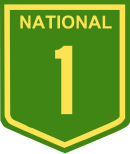Bass Highway (Tasmania)
| Bass Highway | |||||||||||||||||||||||||||||||||||||||||||||||||||||||||||||||||||||||||||||||||||||||||||||||||||||||||||||||||||||||||||||||||||||||||||||||||||||||||||||||||||||||||||||||||||||||||||||||||||||||||||||||||||||||||||||||||||||||||||||||||
|---|---|---|---|---|---|---|---|---|---|---|---|---|---|---|---|---|---|---|---|---|---|---|---|---|---|---|---|---|---|---|---|---|---|---|---|---|---|---|---|---|---|---|---|---|---|---|---|---|---|---|---|---|---|---|---|---|---|---|---|---|---|---|---|---|---|---|---|---|---|---|---|---|---|---|---|---|---|---|---|---|---|---|---|---|---|---|---|---|---|---|---|---|---|---|---|---|---|---|---|---|---|---|---|---|---|---|---|---|---|---|---|---|---|---|---|---|---|---|---|---|---|---|---|---|---|---|---|---|---|---|---|---|---|---|---|---|---|---|---|---|---|---|---|---|---|---|---|---|---|---|---|---|---|---|---|---|---|---|---|---|---|---|---|---|---|---|---|---|---|---|---|---|---|---|---|---|---|---|---|---|---|---|---|---|---|---|---|---|---|---|---|---|---|---|---|---|---|---|---|---|---|---|---|---|---|---|---|---|---|---|---|---|---|---|---|---|---|---|---|---|---|---|---|---|---|---|---|---|---|---|---|---|---|---|---|---|---|---|---|---|---|
 
|
|||||||||||||||||||||||||||||||||||||||||||||||||||||||||||||||||||||||||||||||||||||||||||||||||||||||||||||||||||||||||||||||||||||||||||||||||||||||||||||||||||||||||||||||||||||||||||||||||||||||||||||||||||||||||||||||||||||||||||||||||
| Basic data | |||||||||||||||||||||||||||||||||||||||||||||||||||||||||||||||||||||||||||||||||||||||||||||||||||||||||||||||||||||||||||||||||||||||||||||||||||||||||||||||||||||||||||||||||||||||||||||||||||||||||||||||||||||||||||||||||||||||||||||||||
| Operator: | THIS | ||||||||||||||||||||||||||||||||||||||||||||||||||||||||||||||||||||||||||||||||||||||||||||||||||||||||||||||||||||||||||||||||||||||||||||||||||||||||||||||||||||||||||||||||||||||||||||||||||||||||||||||||||||||||||||||||||||||||||||||||
| Start of the street: |
Launceston ( 41 ° 27 ′ S , 147 ° 9 ′ E ) |
||||||||||||||||||||||||||||||||||||||||||||||||||||||||||||||||||||||||||||||||||||||||||||||||||||||||||||||||||||||||||||||||||||||||||||||||||||||||||||||||||||||||||||||||||||||||||||||||||||||||||||||||||||||||||||||||||||||||||||||||
| End of street: |
C213 comeback Road C214 Arthur River Road Marrawah ( 40 ° 56 ' S , 144 ° 42' O ) |
||||||||||||||||||||||||||||||||||||||||||||||||||||||||||||||||||||||||||||||||||||||||||||||||||||||||||||||||||||||||||||||||||||||||||||||||||||||||||||||||||||||||||||||||||||||||||||||||||||||||||||||||||||||||||||||||||||||||||||||||
| Overall length: | 289 km | ||||||||||||||||||||||||||||||||||||||||||||||||||||||||||||||||||||||||||||||||||||||||||||||||||||||||||||||||||||||||||||||||||||||||||||||||||||||||||||||||||||||||||||||||||||||||||||||||||||||||||||||||||||||||||||||||||||||||||||||||
|
States : |
|||||||||||||||||||||||||||||||||||||||||||||||||||||||||||||||||||||||||||||||||||||||||||||||||||||||||||||||||||||||||||||||||||||||||||||||||||||||||||||||||||||||||||||||||||||||||||||||||||||||||||||||||||||||||||||||||||||||||||||||||
|
Course of the road
|
|||||||||||||||||||||||||||||||||||||||||||||||||||||||||||||||||||||||||||||||||||||||||||||||||||||||||||||||||||||||||||||||||||||||||||||||||||||||||||||||||||||||||||||||||||||||||||||||||||||||||||||||||||||||||||||||||||||||||||||||||
The Bass Highway is a trunk road in the north of the Australian state of Tasmania . For long stretches it runs along the north coast of the island and forms the only connection to its north-western tip. From Launceston to Burnie , the Bass Highway is part of National Highway 1. From Burnie to Marrawah , in the far north-west of Tasmania, it is run as the A2 state road .
course
Launceston to Burnie (N1)
The Bass Highway begins in the southern suburbs of Launceston as a continuation of the Midland Highway (N1) and initially heads west, past the towns of Westbury and Deloraine . In this area, the newly traced motorway (see below) runs parallel to the Meander Valley Highway (B54).
After Deloraine it turns to the northwest and reaches the north coast of the island at the port city of Devonport . Via Ulverstone , she continues her way along the coast to Burnie, where the Ridgley Highway (B18) branches off to the south.
Burnie to Marrawah (A2)
From Burnie the Bass Highway continues to follow the coast, but is no longer a national road, but a Tasmanian state road. In Somerset , the Murchison Highway (A10), the main connection to the west coast of the island, branches off to the south. Further to the northwest, the Bass Highway bypasses the town of Wynyard and then Rocky Cape National Park .
South of Stanley , the highway reaches its northernmost point. There the Stanley Road (B21) branches off north to the peninsula of the same name, while the Bass Highway branches off west to the town of Smithton . There it leaves the north coast and leads through the interior to its end point in the settlement of Marrawah in the northernmost part of the west coast.
history
Origin of name
The Bass Highway is named after Captain Matthew Flinders' ship's doctor George Bass , who discovered the Bass Strait , a shipping route between Tasmania and Australia.
Reallocations
Many parts of the Bass Highway have been redrawn since 1980. This began with the construction of the Southern Outlet in Launceston, which connects downtown to the Midland Highway and was built in the early 1980s. At the same time, the Bass Highway was extended so that it joined the new stretch of road. Since that time, the trunk road has been expanded to four lanes almost along its entire length to Burnie, provided with overtaking lanes and small towns were given bypasses.
On the Launceston – Deloraine route, this affected Hadspen and Carrick in the 1980s and Deloraine himself in the 1990s. The longest bypass in this area, for the towns of Hagley and Westbury, was completed in 2001. The old route is now called the Meander Valley Highway (B54) and is being promoted as a tourist route.
The Latrobe – Somerset route was also treated in the same way. The population there was more in agreement, as the highway there is used for rush-hour traffic in many areas and is less of a tourist route. The economy there is not so dependent on tourists.
source
- Steve Parish: Australian Touring Atlas . Steve Parish Publishing, Archerfield QLD 2007. ISBN 978-1-74193-232-4 . Pp. 55, 60, 61